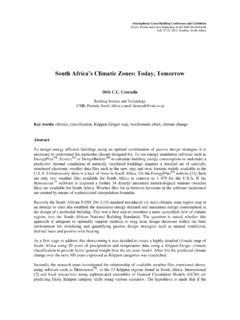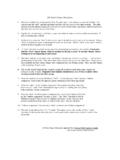Transcription of Key issues impacting the Indian oil and gas sector
1 India s energy security Key issues impacting the Indian oil and gas sector2Fo rewo rd1 India s real economic growth averaged around 8 per cent in the past decade, leading to per cent growth in the demand for energy. Given the projected economic growth levels, energy demand is expected to continue to rise; rising energy needs, in turn, have drawn attention to the importance of energy security. Energy security is ensured by guaranteeing three factors availability, accessibility and affordability of energy , oil and natural gas are the most important sources of primary energy in India. Inadequate domestic supplies of these hydrocarbons are forcing the country to increase its import bill. While the country remains highly dependent on oil imports, it is saddening to note that supply of natural gas, which was expected to alleviate our energy security from the new domestic driven by accelerated capacity addition in power generation and decline in domestic coal production, India s imports of coal have risen.
2 Is rising; consequently, India faces a challenge in its efforts to ensure energy security. The changing geo-political situation is hampering the accessibility of resources in a number of castes. Increasing strategic reserves, enhancing funds for oil equity and investing in oil diplomacy have acquired much prominence. resources is needed. Additionally, accelerated development of energy infrastructure, human resource development and technological up- conducive policy environment coupled with an effective regulatory regime is, without doubt, the basis for accelerated growth of domestic energy resources. Energy security needs integrated This initiative National Seminar for Energy Security ! who will brainstorm on the crucial issues pertaining to energy security in India with to the objective of charting a roadmap for the future.
3 FICCI and Ernst & Young have jointly prepared and guidelines for the discussions. The paper reviews the current scenario of rising energy demand in India which has led to increasing dependence on imports driven primarily by declining domestic production. It also reviews governing India s oil and gas sectors, highlighting the shortcomings and suggesting reforms. " outcomes of the National Seminar for Energy Security informative and helpful in ensuring energy security for the Rajiv Kumar Secretary General FICCI>2 ContentsIndia s impending energy crisis 3 Key issues limiting growth and development of India s oil and gas industry 5A. Upstream 5B. Midstream 8C. Downstream 93 Currently, India is one of the world s fastest-growing economies. During the period between 2006 and 2010, the country s gross domestic product (GDP) increased at a CAGR of , while global GDP increased at a CAGR of The rapid increase in economic activity has been accompanied by rising energy consumption.
4 During the period between 2006 and 2010, India s primary energy consumption increased at a CAGR of , from million tons # $'* +/ 7:< : '* + = and natural gas are major sources of primary energy in India, accounting for , and , respectively, of the primary energy consumption. Although the country has the world s fourth-largest coal reserves, the demand-supply gap of coal has been consistently increasing, with domestic * " just of the world s proven oil reserves while accounting for of the global oil consumption thus importing 73% of its oil consumed. Similarly, the country has of the world s proven natural gas reserves, while accounting for of the worldwide gas consumption, which results in India importing nearly 20% of its natural gas consumed through India s impending energy crisisMMTP ercentage*FY11: numbers are provisionalSource: Petroleum Planning & Analysis Cell, Ernst & Young analysisFigure 1: India s rising dependence on oil crude oil production (million tonnes)Domestic petroleum products consumption (million tonnes)Import dependence (%)Rising dependence on imported oil is a cause for concern J on imported oil has steadily increased as a result of stagnant domestic production and rising demand.
5 This high dependence on imported crude oil has K O prospectivity, delays in the commissioning of new projects and declining production from existing 1. Q + K V :XZZ " ' [ 2. BP Statistical Review of World Energy 20114 Disruption in crude oil supplies has always been a cause for concern for India. The Middle East and North Africa, which supplies 60% of India s oil requirements have witnessed high degree of geopolitical volatility in recent The recent upheaval in the Middle East, especially in Libya and Egypt triggered a drop in crude oil production in the region, resulting in increased O " 4 According to Goldman Sachs, the increase in oil price by US$10 per barrel could potentially slow India s GDP growth X :] O by In addition, the increase in oil prices could O The recent depreciation of the rupee raised the cost of crude oil imports for India, which in turn has led O [ Notably, the import of crude oil and oil products rose from US$ billion in FY06 to US$ billion in " [^Z: $.]]
6 XZZ/ US$75 reserves for the country to deploy in other critical infrastructure and social projects. Gas shortages persist, notwithstanding production Currently, around 32% of demand for gas in the country is unmet as domestic supplies are not adequate enough to meet current demand. In FY10, the domestic gas supply scenario improved, with the _`kKz { However, a steady drop in production from the KG-D6 ! zX Z~ZZ <7 :~Z: ! of domestic of price affordability and pipeline infrastructure. # natural gas (LNG) terminals were located in the western part of the country. As a result, the pipeline infrastructure was concentrated only in the western India, which has adversely impacted the availability of gas in the rest of the country. The low availability of gas and limited infrastructure has curtailed _`kKz `= ` V methane (CBM) and new LNG facilities.}
7 In spite of the demand for gas in the country. According to the Integrated Energy Policy by the Government of India (GoI), India s requirement of primary commercial energy is projected to increase 77Z '* + [^Z: Z : '* + [^ : 9 Rising consumption will be driven by economic growth and high fuel demand. The global average Z # $_` +/ " J 7<7 _` + * substantial potential for growth in energy To meet the growing energy demand over the next few years, India will have to enhance its energy security by procuring energy supplies at affordable Q and is an exporter of petroleum products, major investments will have to be made in the domestic upstream industry and to acquire hydrocarbon reserves + " J The Economic Times, 9 February 2011, via Factiva, 2011 The Times of India Group4.]]
8 J + " ' :XZZ [ :XZZ * + Intelligence Unit Ltd5. " J `K ` V * * " :< :XZZ [ :XZZ Pulse Pty Limited6. K = ` " + " K Z< :XZZ7. PPAC, Data for Crude and Products - Value in Rupees, accessed 7 December 2011 8. Reliance Industries Limited, Analyst Presentations, July 27, 2010 and November 2011 9. " + = ` " 10. + $ # / Q ZZ :XZZ5 The Indian oil and gas industry has to deal with myriad issues . While some of the challenges such as regulatory uncertainty, subsidized petroleum prices oil and gas industry, players still need to address the impact of inadequate and ageing infrastructure. Some of the important issues faced across the value chain are discussed below. Inadequate upstream infrastructure11 The upstream oil and gas infrastructure in India is inadequate due to underinvestment in the past.]]
9 As a result, the production of oil and gas remained rise in demand. The sector has limited participation from foreign and private players as is visible from their declining participation in New Exploration Licensing Policy (NELP) rounds. For instance, a total of 21 foreign companies participated in NELP-VII $:XX / + k """ $:XX / NELP-IX (2011).12 Further, companies have spent just US$ billion, out of their investment commitment of US$ billion until NELP Although the unexplored sedimentary area in the country decreased from 41% in FY99 to 12% in FY10, the level of exploration will have to be further raised to increase hydrocarbon 15 The rising demand for oil and gas has resulted in an increase in exploration activities worldwide, leading deepwater rigs.
10 In line with the global trend, India is equipment. Companies are increasingly falling short of their exploration targets with a high incidence of * in the manufacture of rigs, particularly deepwater rigs, and the time lag in the delivery of new rigs. Further, most of the rig assets held by Indian companies are have to be retired or substantially upgraded to remain shortage. In addition to rigs, there is a scarcity of other upstream-related infrastructure such as process platforms, pipelines, collecting stations and other surface facilities to transport oil and gas from wells to delivery issues limiting growth and development of India s oil and gas industry A." and gas discoveries. Since the introduction of NELP in 1999, there have been 60 discoveries, out of which 51 are gas discoveries.















